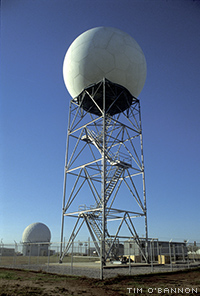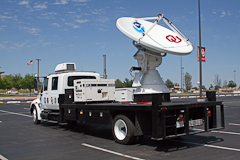Research Tools: Radar
Radar is one of the most valuable tools available to a forecaster. From the original WSR-57 research project to Doppler radar, NEXRAD, dual-polarization technology and phased array radar, NSSL's research has truly changed the face of weather forecasting.
NEXRAD
NSSL scientists helped develop the Weather Surveillance Radar - 1988 Doppler (WSR-88D) radars, also known as NEXt-generation RADar (NEXRAD). Since the first Doppler weather radar became operational in Norman in 1974, NSSL has worked to extend its functionality and effectiveness, and proved to the NOAA National Weather Service (NWS) that Doppler weather radar was a crucial forecasting tool. The NWS now has a network of 158 NEXRADs.
NSSL continues to develop and improve algorithms that detect and notify forecasters of hail, severe thunderstorms, tornadic circulations, downbursts and gust fronts. Research to operations activities also include developing and improving signal processing techniques.
Read more about NEXRAD research to operations activities→
Dual-Polarized Weather Radar (Dual-Pol)
Dual-polarized (dual-pol) radar technology is truly a NOAA-wide accomplishment. NSSL spent nearly 30 years researching and developing the technology. The National Weather Service (NWS) and NSSL developed the specifications for the modification, which was tested by engineers at the NWS Radar Operations Center. The NWS Warning Decision Training Branch provided timely and relevant training to all NWS forecasters who would be using the technology.
The upgraded radars offer 14 new radar products to better determine the type and intensity of precipitation, and can confirm tornadoes are on the ground causing damage. Dual-pol is the most significant enhancement ever made to the nation's radar network since Doppler radar was first installed in the early 1990s.
Phased Array Radar
NSSL has led the effort to research phased array radar technology with the National Weather Radar Testbed phased array radar. It is also being evaluated as a Multi-function Phased Array Radar (MPAR), a possible cost-effective replacement for aging weather and aircraft tracking radars.
Multi-Function Phased Array Radar (MPAR)
More than 350 FAA radars and by 2025, nearly 150 of the nation's Doppler weather radars will need to be either replaced or have their service life extended. Phased array radars have been used by the military for many years to track aircraft. NSSL's MPAR program is investigating the potential to determine if both the aircraft surveillance and weather surveillance functions can be combined into one radar. Combining the operational requirements of these various radar systems with a single technology solution would result in an estimated savings to the nation of $4.8 billion in acquisition and maintenance costs. Services could improve dramatically despite being able to reduce the number of radars by 35 percent.
Mobile Radar
NSSL researchers teamed up with several universities to build the first ever mobile Doppler radar: a Doppler radar mounted on the back of a truck. The mobile radar can be driven into position as a storm is developing to rapidly scan the atmosphere at low levels, below the beam of WSR-88D radars. NSSL has used mobile radars to study tornadoes, hurricanes, dust storms, winter storms, mountain rainfall, and even swarms of bats.
Past Radar Research Highlights
- Joint Doppler Operational Project (JDOP). NSSL conducted JDOP to prove that Doppler radar could improve the nation's ability to warn for severe thunderstorms and tornadoes. This led to the decision in 1979 by the National Weather Service (NWS), the U.S. Air Force's Air Weather Service, and the Federal Aviation Administration (FAA) to include Doppler capability in their future operational radars.
- The Joint POLarization Experiment (JPOLE). J-POLE in 2002 tested the capabilities of NSSL's experimental polarized Doppler radar. Intercept vehicles verified precipitation in the field and a T-28 research aircraft collected cloud microphysics data to help assess radar data and product quality. In 2004, the NEXRAD Program Management Committee approves taking first steps towards upgrading the national operational WSR-88D network to include dual-polarimetric capabilities developed by NSSL. The upgrade will be complete in 2013.



